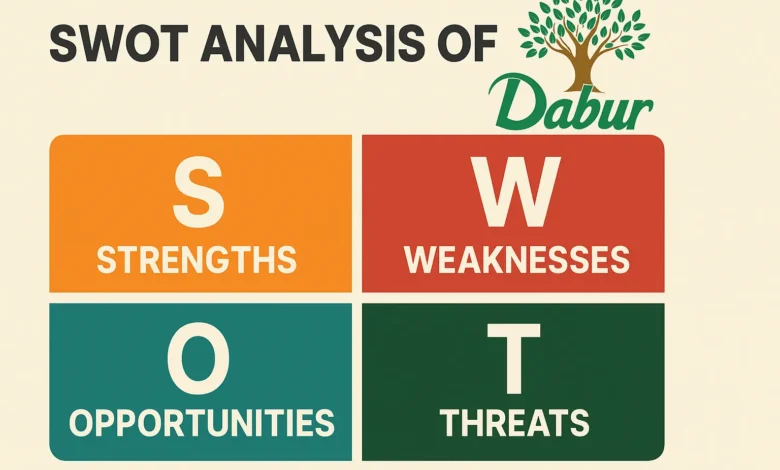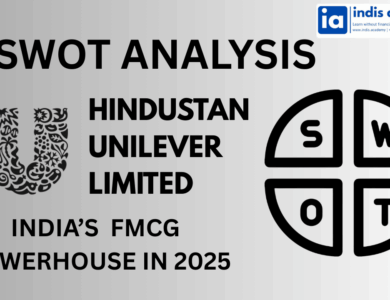Complete SWOT Analysis of Dabur – Inside the Strategy of India’s Ayurvedic Giant
Explore Dabur's 2025 SWOT analysis, uncovering strengths, weaknesses, opportunities, and threats. Gain insights into its Ayurvedic leadership and market strategy

When you think of Ayurveda in India, one of the first names that comes to mind is Dabur. From the iconic Chyawanprash and Hajmola to the refreshing Real fruit juices and the trusted Vatika hair oil, Dabur has become more than a brand—it’s a part of Indian households across generations.
Founded over 135 years ago, Dabur has positioned itself as a natural, herbal, and Ayurvedic wellness brand, blending ancient science with modern FMCG strategies. As global demand for immunity-boosting, chemical-free, and sustainable products grows, Dabur stands at the sweet spot of trust and trend.
But in a market now flooded with homegrown startups, global FMCG giants, and changing consumer preferences, the question arises: Can Dabur maintain its Ayurvedic dominance in the modern world?
In this article, we’ll break down the SWOT analysis of Dabur, exploring its Strengths, Weaknesses, Opportunities, and Threats to understand how the company plans to lead the next phase of India’s health and wellness revolution.
Also read: Complete SWOT Analysis of Patanjali – India’s Leading Ayurvedic Brand
Company Overview – About Dabur
Dabur India Ltd is one of the oldest and most respected names in India’s FMCG (Fast-Moving Consumer Goods) sector, with a rich legacy that dates back to 1884. Founded by Dr. S.K. Burman, the company started as a small Ayurvedic medicine manufacturer in Kolkata, with a mission to make healthcare affordable and accessible for all.
Today, Dabur operates across multiple categories including:
- Healthcare (Chyawanprash, Honitus, Dabur Honey)
- Personal Care (Vatika, Dabur Amla, Meswak)
- Foods & Beverages (Real Juice, Hajmola, GlucoPlus)
- Home Care & Ayurvedic OTC products
With its headquarters in Ghaziabad, Uttar Pradesh, Dabur has expanded its operations globally, with a presence in over 100 countries, and enjoys high trust levels among both rural and urban consumers.
The company generated over ₹12,000 crore in revenue in FY23 and continues to lead the Ayurvedic and herbal segment in India, making it a pioneer in the natural wellness movement. Its mantra—“Celebrate Life Naturally”—perfectly encapsulates its mission to merge tradition with innovation.
What is SWOT Analysis?
A SWOT analysis is a strategic planning framework used to evaluate a company’s internal strengths and weaknesses, as well as external opportunities and threats. It helps businesses assess where they stand, how they can grow, and what risks they need to mitigate to stay competitive.
Here’s what each element of SWOT stands for:
- S – Strengths: Internal factors that give a company a competitive edge
- W – Weaknesses: Internal limitations that may hinder growth or efficiency
- O – Opportunities: External trends the company can leverage for expansion
- T – Threats: External challenges that could impact business stability or performance
In the context of Dabur, a SWOT analysis helps us understand how a legacy Ayurvedic brand continues to thrive in a fast-evolving FMCG landscape—while adapting to modern trends like natural wellness, digital commerce, and sustainability.
Also read: Complete SWOT Analysis of Patanjali – India’s Leading Ayurvedic Brand
Dabur’s Strengths
With over a century of experience and trust, Dabur has built a rock-solid foundation in India’s FMCG sector. Its focus on Ayurveda, health, and natural wellness has helped it stand apart in an industry dominated by synthetic and chemical-heavy competitors. Here are the major strengths that drive Dabur’s success:
1. Strong Brand Legacy and Trust
Founded in 1884, Dabur is one of India’s most recognized and respected FMCG brands. Its deep-rooted Ayurvedic identity and long-standing presence across generations give it a level of trust that’s difficult for new entrants to replicate.
2. Wide and Diversified Product Portfolio
Dabur offers more than 250+ products across healthcare, personal care, oral care, hair care, and foods. Flagship names like Chyawanprash, Honitus, Real Juice, Dabur Amla, and Vatika make it a one-stop solution for Indian households.
3. Natural and Ayurvedic Positioning
Unlike typical FMCG giants, Dabur owns a unique space in the market—leveraging Ayurveda and natural science to create products that align with India’s traditional wellness values, as well as growing global demand for clean-label alternatives.
4. Pan-India and Global Presence
Dabur has an impressive distribution network of over 6 million retail outlets in India, with strong penetration in both urban and rural markets. Internationally, Dabur is present in 100+ countries, especially in the Middle East, Africa, SAARC nations, and the US.
5. Strong R&D and Product Innovation
The brand continues to evolve through innovation. It has introduced Ayurvedic baby care, health supplements, and immunity-boosting combos during the COVID-19 wave, demonstrating agility in product development.
6. Effective Marketing and Brand Communication
Dabur uses emotional storytelling, Ayurveda-based education, and celebrity endorsements to connect with diverse audiences. It also collaborates with influencers and uses regional campaigns to connect with local communities.
Dabur’s Weaknesses
While Dabur enjoys a strong legacy and wide acceptance, it’s not without its internal limitations. As consumer preferences shift and new players disrupt the FMCG space, Dabur must address several key weaknesses to maintain its leadership.
1. Limited Penetration in Premium Urban Segments
Despite its strong rural and mass-market appeal, Dabur struggles to capture premium urban consumers who often associate the brand with traditional or value-based products. High-end personal care and wellness markets remain dominated by global brands and newer D2C entrants.
2. Overdependence on Select Flagship Products
A significant portion of Dabur’s revenue comes from a few core products like Chyawanprash, Real Juice, and Dabur Amla Hair Oil. Any decline in demand for these products could directly affect overall performance.
3. Slower Innovation Compared to Startups
While Dabur has made strides in product development, it still lags behind fast-moving D2C startups in launching trendy, millennial-focused items like clean skincare, vegan beauty, or functional superfoods.
4. Gaps in Packaged Food & Dairy Segments
Compared to brands like Nestlé, Amul, or ITC, Dabur has a narrower product base in the packaged foods and dairy categories, missing out on high-growth segments like instant meals, yogurts, and ready-to-cook options.
5. Brand Dilution Risk
With Dabur expanding into diverse segments—from baby care to mosquito repellents—there’s a growing risk of brand identity dilution. Over-diversification might weaken its core Ayurvedic positioning if not handled strategically.
These weaknesses underline the importance of strategic focus, faster innovation, and stronger brand segmentation—especially if Dabur wants to keep pace with evolving consumer preferences in the FMCG space.
Dabur’s Opportunities
Dabur is uniquely positioned to capitalize on major shifts in consumer behavior, health consciousness, and global interest in Ayurveda. With its brand trust and Ayurvedic foundation, it has several high-potential opportunities to scale further—both in India and internationally.
1. Surge in Demand for Ayurvedic & Immunity-Boosting Products
Post-pandemic, consumers are actively seeking natural, chemical-free, and preventive wellness solutions. Dabur can lead the charge by launching new Ayurvedic SKUs, immunity drinks, wellness supplements, and on-the-go herbal products tailored for modern lifestyles.
2. Deeper Rural Market Penetration
While Dabur already has a strong rural presence, it can further expand by launching affordable sachets, AYUSH-based remedies, and rural-focused health awareness campaigns—especially in underpenetrated states and tribal belts.
3. Direct-to-Consumer (D2C) and E-commerce Growth
By investing in D2C platforms, personalized subscription models, and exclusive online launches, Dabur can reach young, urban, health-conscious shoppers directly—without relying solely on retail distribution.
4. Global Expansion of Ayurveda
With increasing interest in Ayurveda and herbal remedies across Europe, the US, and the Middle East, Dabur can strengthen its export strategy by introducing localized Ayurvedic solutions, backed by scientific validation and certifications.
5. Functional Foods & Health Beverages
Rising awareness around gut health, mental wellness, and energy has opened the door to functional foods, adaptogenic herbs, and natural drinks. Dabur can explore Ayurvedic teas, nutrition bars, probiotic drinks, and more.
6. Sustainability & Ethical Branding
Consumers are now rewarding brands that walk the talk on the environment. Dabur can boost brand loyalty by going further on eco-friendly packaging, cruelty-free products, and carbon-neutral operations.
By seizing these opportunities, Dabur can evolve from a legacy Ayurvedic brand into a global wellness innovator, winning over both traditional loyalists and new-age consumers alike.
Dabur’s Threats
As the FMCG landscape becomes more competitive and consumer preferences shift rapidly, Dabur faces several external threats that could challenge its market share and brand value. Here are the key risks the brand must manage proactively:
1. Intense FMCG Competition
Dabur competes with both established FMCG giants like HUL, ITC, Marico, and Emami, as well as new-age D2C brands like Mamaearth, Kapiva, and The Ayurveda Co. These brands are aggressive in marketing, digital-first, and often quicker to innovate.
2. Brand Switching Among Younger Consumers
Gen Z and urban millennials are exploring niche, ingredient-focused brands that are modern, minimalist, and story-driven. If Dabur doesn’t update its brand language and packaging, it risks losing relevance with these digital-savvy buyers.
3. Supply Chain Disruptions
Dabur’s raw materials like Amla, Tulsi, Honey, and Aloe Vera are seasonal and agriculture-dependent. Climate change, poor harvests, or supply shortages can disrupt production, increase costs, or affect product quality.
4. Regulatory Scrutiny on Product Claims
Ayurvedic and herbal product categories are under increasing regulatory and scientific scrutiny. A single misleading health claim or mislabeling incident can lead to legal backlash, customer distrust, and brand damage.
5. Price Wars in Rural & Value Segments
In price-sensitive rural areas, local brands and low-cost alternatives are rapidly emerging. Maintaining margins while remaining affordable is a continuous challenge, especially with rising input and distribution costs.
6. Economic Slowdowns or Inflation
In periods of economic stress, consumers may cut back on discretionary purchases like premium health juices or specialized wellness products. This could hurt Dabur’s top-selling segments in personal and healthcare.
These threats emphasize the need for Dabur to stay agile, transparent, and strategically focused, especially as the brand balances its Ayurvedic heritage with modern-day expectations.
Competitive Strategy & Future Outlook
Dabur’s strategy is rooted in its Ayurvedic legacy, but its growth path is increasingly shaped by modern FMCG trends, digital innovation, and consumer wellness priorities. Here’s how the brand is staying competitive and future-ready:
1. Omnichannel Distribution Model
Dabur has built a powerful retail presence across general trade, modern trade, and e-commerce. The brand is now strengthening its D2C platforms, partnering with Amazon, Flipkart, BigBasket, Nykaa, and expanding into quick commerce via Blinkit and Zepto.
2. Innovation with Ayurvedic Edge
Dabur is launching new-age products like Dabur Vedic Tea, immunity kits, and Ayurvedic baby care, aligning traditional wisdom with current consumer needs. The focus is on science-backed Ayurveda and ingredient-led product storytelling.
3. Youth-Centric Branding
To attract millennials and Gen Z, Dabur is investing in influencer marketing, regional content, and packaging redesigns. The goal is to position Ayurveda as cool, convenient, and accessible for younger audiences.
4. Sustainability as a Growth Pillar
Dabur has committed to plastic waste neutrality, eco-friendly packaging, and carbon-neutral operations at several manufacturing units. These efforts not only reduce environmental impact but also build trust with ethical consumers.
5. Expanding Global Ayurvedic Reach
Dabur is scaling operations in the US, Middle East, Africa, and Europe, launching products suited to NRI audiences and Ayurveda-aware global markets. This move strengthens its international footprint and revenue diversification.
Outlook
With a balanced approach between tradition and transformation, Dabur is positioned to evolve from a legacy Indian brand into a global wellness powerhouse. Its success will lie in how well it continues to innovate with purpose, stay agile with execution, and remain authentic in its Ayurvedic roots.
Conclusion & Final Thoughts
Dabur’s journey from a small Ayurvedic pharmacy in 1884 to a multi-billion-rupee FMCG powerhouse is a remarkable example of brand evolution rooted in trust and tradition.
It continues to command consumer loyalty across urban and rural India through its focus on natural wellness, affordability, and time-tested formulations.
This SWOT analysis shows that while Dabur enjoys unmatched brand credibility, a diverse product portfolio, and strong distribution, it must accelerate innovation, modernize its brand appeal, and respond swiftly to new-age consumer demands—especially from health-conscious, digital-first audiences.
With rising interest in Ayurveda globally, the clean-label movement gaining traction, and consumers seeking brands that stand for both heritage and responsibility, Dabur is well-positioned to lead India’s next wave of holistic wellness and sustainable FMCG—not just at home, but across the world.





